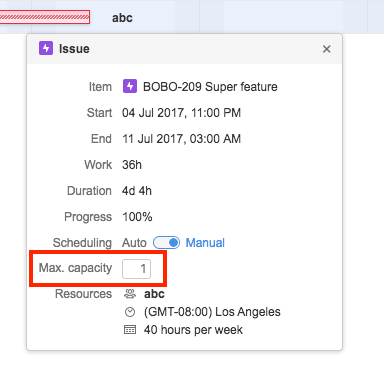These release notes are intended for our EAP program members. We assume that you have read previous documentation on Structure.Gantt. If not, please start by checking out Structure.Gantt 0.3 – Getting Started, Structure.Gantt 0.4 – Release Notes and Structure.Gantt 0.7 – Release Notes
New features
Drag and drop now works even if tasks' resource time zone or calendar doesn't match Gantt chart calendar or current user time zone
New dependency types
Resource Availability settings
Task maximum capacity
See below for detailed information on each feature.
Installation
Structure.Gantt 0.9 supports only Structure 4.3 or later. Jira 7.2 - 7.5 are supported
Structure 4.3 has several issues with the recently released Jira 7.6, so please wait until Structure compatibility release is available
Until Structure.Gantt is available on the Atlassian Marketplace, it should be installed via file upload (Administration | Add-ons | Manage add-ons | Upload add-on).
Upgrading
If you already have production data on Gantt, please do a database or JIRA backup before upgrading.
Please review your Gantt configuration after upgrading. First of all, there are new options. Secondly, please double-check that your preferred settings remain.
Handling of resource calendars and time zones
In the previous version it was not possible to reschedule a task by drag-and-drop if the calendar or the time zone set for the resource of this task were different from the ones set for the gantt chart.
This version has several improvements in this regard:
Highlighting of such tasks. You’ll see a small time/calendar icon along the left side of the gantt chart for such tasks.
You can now reschedule such tasks using drag-and-drop.
If the time zones are different, as you drag the task, you’ll see the time in the gantt chart time zone at the top and in the resource time zone below it.
If the calendars are different, the resource calendar will be used for scheduling as you move the task, instead of the gantt calendar. For example, if the task resource doesn’t work Saturday to Monday, you won’t be able to schedule the task for Monday - it will snap either to Friday or Tuesday as you try to schedule it.
Resource calendar is used for calculation of a task duration too. For example, if your Gantt uses standard calendar (8-hour work day, 5 days a week) but your resource works 24/7, the task can be scheduled for any day of the week and its duration will be calculated based on 24-hour work day, not 8 hours.
If you click a task, you can see the resource time zone and calendar in the task details panel.
New dependency types
Now you can define and use all types of dependencies:
- Finish to Start
- Finish to Finish
- Start to Start
- Start to Finish
You can create FS dependency using the mouse as before. Dependencies of other types can be created via the dialog only (select an issue and click the Links button in the toolbar).
Resource availability settings.
In the previous version you could select the default calendar for all resources and then different calendars for individual resources. Now you can adjust availability of a resource even further - adding days off, periods of part-time work or any other adjustments. To do so, open Resource Settings for a resource and switch to the Availability tab.
Specify the start and end dates of the period and the percentage of the resource availability. You can not create intersecting periods, but you can create periods open on one side - one without the start date (the earliest period) and one without the end date (the last period).
The periods you create are shown in a table ordered chronologically.
Task maximum capacity
In the task details panel, which is shown when you click the task, you can now set maximum capacity for this task.
This parameter defines how much of the resource capacity the task can use. For example, you have a team resource with the capacity of 5 and this resource is assigned to an Epic. If you set maximum capacity of this Epic to 3, it means only 3/5 of the resource full capacity will be used on this task (3 out of 5 people in the team will be working on it).
Known issues
The following issues either are known problems or non-obvious behavior in the current version.
- If formula is selected as the source for resource assignment, any changes in formula won't update the resource list once it's been built (for example, if your formula had a variable assigned to one column and you reassign variable to another column after the resource list has already been built, the resource list will not be updated to reflect this change)
- Bars can disappear from the chart due to a security level if a structure owner doesn't have permission to see it (even for admin)


